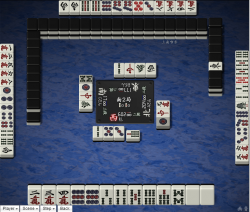Riichi strategy

Strategy surrounding the call for riichi entails various considerations.
Advantages
- Any closed hand becomes eligible for winning by ron.
- Riichi is an automatic yaku and is eligible to count for 1 additional han (after a win).
- Access to the ura-dora (after a win).
- Kans formed by any player provide two extra dora indicators for the riichi declarer instead of one.
- Other players are recommended to defend against riichi calls, if possible or needed. Otherwise, players run the risk of falling to that hand.
Disadvantages
- It is less likely for opponents to deal in.
- By rule, the hand is locked. Therefore, it is impossible to change the composition of the hand in order to get a better wait or an improved score.
- Likewise, a player can no longer defend and instead wait for a winning tile.
- Other players still have the option to develop their hands and potentially "snipe" the hand. Example.
- It is highly recommended to declare the win on the first instance of a winning tile, even if the tile is a yasume or a lower scoring tile (based on yaku). Otherwise, the hand is subject to furiten.
- A riichi call disables a person's ability to be selective of points from particular players (if need be).
Miscellaneous considerations
Once again, riichi is a discretionary play. In fact, in all instances of considering and calling riichi, risk is involved. Therefore, various factors must be considered before employing using riichi. At the same time, many plays involving riichi are highly recommended. Employing riichi is a matter of the current game state.
Damaten
The alternative to declaring riichi is damaten. This move involves retaining the closed hand in tenpai, without making a declaration.
Game round
Hand shape
Point standing
Tile availability
Miscellaneous questions
- What game round is it?
- Is the lead currently held?
- Overall, what is the current point standing?
- Answer 1
- Point standing have great influence over whether to call riichi or not. In this example, it was completely unnecessary.
- Is it necessary to improve the hand by calling riichi?
- Would damaten be sufficient?
- Answer
- For the first two hands, riichi was not called as the hands were valued enough without the riichi call. A call for riichi in either example produces minimal gain for the risk of riichi.
- Can the hand be improved by drawing particular tiles?
- How many tiles are available for winning?
- Is it safe to discard the extra tile, to call riichi?
- Did anyone else call riichi previously?
- How many tile draws are left?
- Does the hand require riichi to end the game, while in the preferred position (1st - 3rd)?
- Answer
- Riichi was called here, as the hand is able to end the game by sending a player into negative. Yet, the position of 2nd is retained.
Oikake riichi
Oikake riichi 「追いかけリーチ」 is a declared riichi, after another player had already declared riichi. In this state, two or even three players have simultaneously declared riichi; and thus, the game becomes a contest between two or three tenpai hands. In this state, any riichi declarer is liable of playing into another's riichi call. At the time same, this type of riichi is often utilized because at least one player is not able to defend. With multiple riichis occurring simultaneously, the players end up in a "riichi duel".
The process of four active riichi hands is not possible due to suucha riichi, or four called riichi. In this case, the hand ends if the fourth riichi discard is not a winning tile for any of the previous three.
External links
| |||||||||||